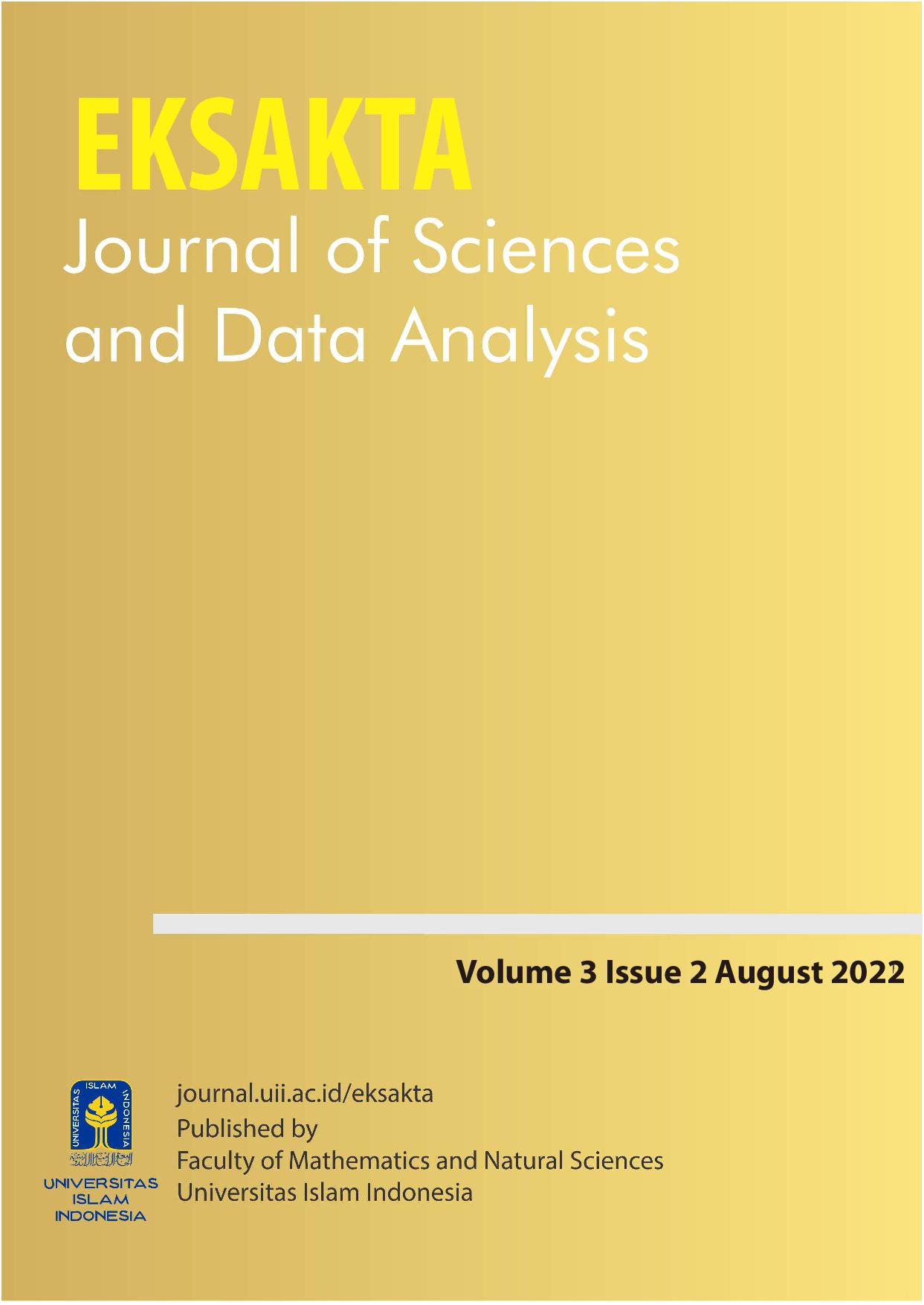Main Article Content
Abstract
The Qur’anic Self-Development (PDQ)-Ta'lim Program is one of the student activities that must be followed by diploma and bachelor program students in Universitas Islam Indonesia (UII). The implementation of PDQ is coordinated by each faculty which is carried out for 4 semesters with 12 meetings for each semester. After carrying out PDQ activities, it is necessary to know the student profiles that can be used as the basis for policy making in the implementation of PDQ activities in the next period. In order to find out the profile of students after participating in PDQ activities, it is necessary to group these students based on related variables. This study uses the ROCK method to group students participating in the PDQ Faculty of Mathematics and Natural Sciences (FMIPA) UII batch 2020. The ROCK method is a robust agglomerative hierarchical-clustering algorithm based on the notion of links. The ROCK method is a suitable clustering method for grouping data with categorical variables. Based on the results of the analysis of the ROCK method of student data for the batch 2020 FMIPA UII, obtained three optimum clusters (k=3) at a threshold value of θ of 0.20. Threshold 0.20 has the smallest SW/SB ratio value of 0.0514 or 5.14% and the largest R-squared value is 61.76% compared to other thresholds.
Keywords
Article Details
Authors who publish with this journal agree to the following terms:
- Authors retain copyright and grant the journal right of first publication with the work simultaneously licensed under a Creative Commons Attribution License that allows others to share the work with an acknowledgment of the work's authorship and initial publication in this journal.
- Authors are able to enter into separate, additional contractual arrangements for the non-exclusive distribution of the journal's published version of the work (e.g., post it to an institutional repository or publish it in a book), with an acknowledgment of its initial publication in this journal.
- Authors are permitted and encouraged to post their work online (e.g., in institutional repositories or on their website) prior to and during the submission process, as it can lead to productive exchanges, as well as earlier and greater citation of published work (See The Effect of Open Access).
References
- DPPAI UII, Pedoman Pengembangan Diri Qur’ani (PDQ) Universitas Islam Indonesia Jenjang Sarjana. Yogyakarta: DPPAI UII, 2020.
- UII, Peraturan Rektor UII tentang SKP dan Aktivitas Kemahasiswaan. 2019.
- DPPAI UII, PDQ/TA’LIM, 2021. https://dppai.uii.ac.id/ondi/.
- S. Guha, R. Rastogi, and K. Shim, Rock: a robust clustering algorithm for categorical attributes, Inf. Syst., 25(5) (2000) 345–366.
- UII gateway. https://gateway.uii.ac.id/akademik.
- V. Silvia, Statistika Deskriptif, Penerbit Andi, Banda Aceh, 2020.
- L. M. Nasution, Statistik Deskriptif, J. Hikmah, 14 (1) (2017) 49–55.
- D. Setyowati, Pelatihan Membuat Grafik Dalam Microsoft Excel. Untuk Pengolahan Dan Penyajian Data, J. Dharma, 2(2) (2019) 101–112.
- J. Hair, R. Anderson, B. Babin, W. Black, Multivariate Data Analysis, 7th ed. Prentice Hall Inc, New Jersey, 2000.
- P.Baby and K.Sasirekha, Agglomerative Hierarchical Clustering Algorithm- A Review, Int. J. Sci. Res. Publ., 3(3) (2013) 2–4.
- S. Sulastri, L. Usman, and U. D. Syafitri, K-prototypes Algorithm for Clustering Schools Based on The Student Admission Data in IPB University, Indones. J. Stat. Its Appl., 5 (2) (2021) 228-242.
- M. A. Putri and S. Abdullah, Clustering analysis of senior high school in West Java based on educational facilities, J. Phys. Conf. Ser., 1725(1) (2021) 1-11
- A. K. Jain and R. C. Dubes, Clustering_Jain_Dubes.pdf. Prentice Hall Inc, New Jersey: 1988.
- J. Reddy and B. Kavitha, Clustering the Mixed Numerical and Categorical Datasets Using Similarity Weight and Filter Method, Int. J. Database Theory Appl., 5(1) (2012) 121–133.
- M. J. Bunkers and J. R. Miller Jr, Definition of Climate Regions in the Northern Plains Using an Objective Cluster Modification Technique, J. Clim., 9 (1996) 130–146.
- G. D. Kader and M. Perry, Variability for categorical variables, J. Stat. Educ., 15(2) (2007) 1-18.
- Alvionita, Sutikno, and A. Suharsono, Ensemble ROCK Methods and Ensemble SWFM Methods for Clustering of Cross Citrus Accessions Based on Mixed Numerical and Categorical Dataset, IOP. Conf. Ser. Earth Environ. Sci., 58 (2017) 1–11.
References
DPPAI UII, Pedoman Pengembangan Diri Qur’ani (PDQ) Universitas Islam Indonesia Jenjang Sarjana. Yogyakarta: DPPAI UII, 2020.
UII, Peraturan Rektor UII tentang SKP dan Aktivitas Kemahasiswaan. 2019.
DPPAI UII, PDQ/TA’LIM, 2021. https://dppai.uii.ac.id/ondi/.
S. Guha, R. Rastogi, and K. Shim, Rock: a robust clustering algorithm for categorical attributes, Inf. Syst., 25(5) (2000) 345–366.
UII gateway. https://gateway.uii.ac.id/akademik.
V. Silvia, Statistika Deskriptif, Penerbit Andi, Banda Aceh, 2020.
L. M. Nasution, Statistik Deskriptif, J. Hikmah, 14 (1) (2017) 49–55.
D. Setyowati, Pelatihan Membuat Grafik Dalam Microsoft Excel. Untuk Pengolahan Dan Penyajian Data, J. Dharma, 2(2) (2019) 101–112.
J. Hair, R. Anderson, B. Babin, W. Black, Multivariate Data Analysis, 7th ed. Prentice Hall Inc, New Jersey, 2000.
P.Baby and K.Sasirekha, Agglomerative Hierarchical Clustering Algorithm- A Review, Int. J. Sci. Res. Publ., 3(3) (2013) 2–4.
S. Sulastri, L. Usman, and U. D. Syafitri, K-prototypes Algorithm for Clustering Schools Based on The Student Admission Data in IPB University, Indones. J. Stat. Its Appl., 5 (2) (2021) 228-242.
M. A. Putri and S. Abdullah, Clustering analysis of senior high school in West Java based on educational facilities, J. Phys. Conf. Ser., 1725(1) (2021) 1-11
A. K. Jain and R. C. Dubes, Clustering_Jain_Dubes.pdf. Prentice Hall Inc, New Jersey: 1988.
J. Reddy and B. Kavitha, Clustering the Mixed Numerical and Categorical Datasets Using Similarity Weight and Filter Method, Int. J. Database Theory Appl., 5(1) (2012) 121–133.
M. J. Bunkers and J. R. Miller Jr, Definition of Climate Regions in the Northern Plains Using an Objective Cluster Modification Technique, J. Clim., 9 (1996) 130–146.
G. D. Kader and M. Perry, Variability for categorical variables, J. Stat. Educ., 15(2) (2007) 1-18.
Alvionita, Sutikno, and A. Suharsono, Ensemble ROCK Methods and Ensemble SWFM Methods for Clustering of Cross Citrus Accessions Based on Mixed Numerical and Categorical Dataset, IOP. Conf. Ser. Earth Environ. Sci., 58 (2017) 1–11.




